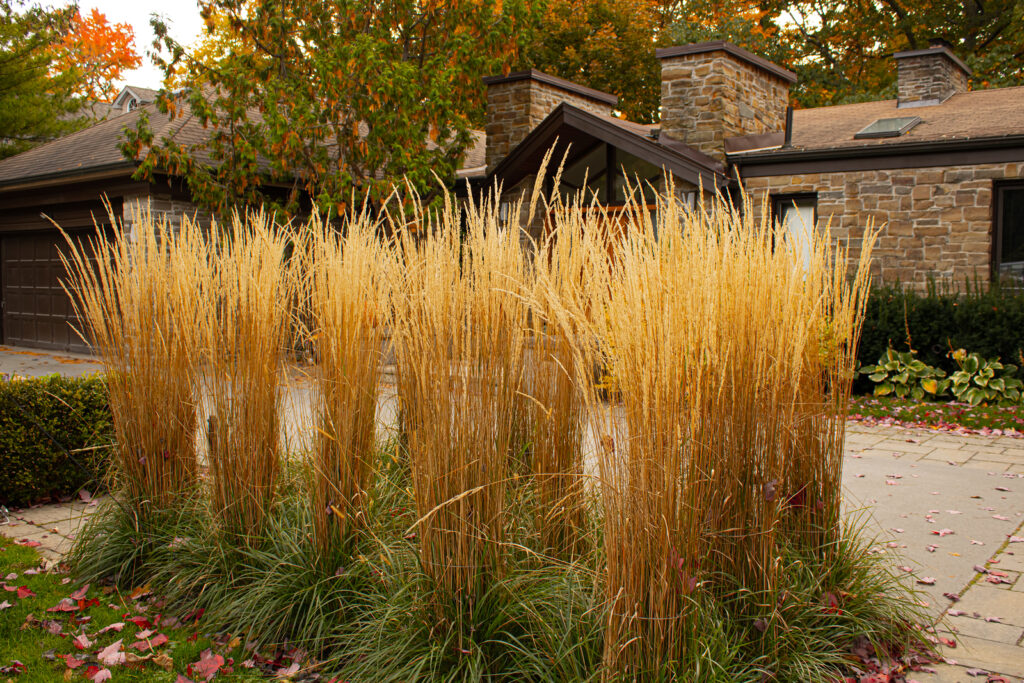Calamagrostis — commonly called feather reed grass–is one of the most handsome ornamental grasses. It has linear, flat, or channeled leaves and dense inflorescences borne in branching panicles. The erect, somewhat arching clumps of narrow, bright leaves grow from 1.5 to 4 feet tall.
Calamagrostis upright flowering stems remain upright until the first snow or freeze. The leaves are green with a purplish tone; they age to golden yellow then turn buff in winter.
Ornamental species of Calamagrostis can be added to herbaceous or mixed borders. The elegant inflorescences are long-lasting.
Calamagrostis is a genus of about 250 species. All are rhizomatous, perennial grasses. They are widely distributed in temperate zones of the Northern Hemispshere. They occur often in marshland and damp woodland.

Get to know Calamagrostis
- Plant type: Perennial grass
- Growing zones and range: Zones 4 to 9
- Hardiness:
- Height and width: 3 to 6 feet x 2 feet (.9 to 1.8m x .6m)
- Growth rate:
- Form and habit: Upright
- Foliage: Spring brings a fountain of erect, somewhat arching clumps of narrow, bright green leaves borne in branching panicles, grow 1.5-4 feet (.5-1.2m) in height
- Flowers: Tall, feathery, pink inflorescences change to light purple in early summer then ripen into golden wheatlike sheaves by midsummer; flowering stems rise 3-4 feet (.9-1.2m) above foliage in late spring or early summer, remain upright until first snow
- Fruits:
- Seeds: Seed heads remain attractive into fall
- Bloom time: Early summer
- Uses: Herbaceous or mixed border
- Garden companions: Black-eyed Susan or sedum for beauty that lasts well into winter
- Common name: Feather reed grass
- Botanical name: Calamagrostis
- Family name: Poaceae
- Origin: Temperate zones of the Northern Hemisphere
Where to plant Calamagrostis
- Plant Calamagrostis in full sun or light shade.
- Plant Calamagrostis in ordinary or moist soil that is well-drained; one of the few grasses that will thrive in wet clay.
- Calamagrostis tolerates seaside conditions.
When to plant Calamagrostis
- Plant container-grown Calamagrostis in the garden in spring or autumn.
Planting and spacing Calamagrostis
- Space Calamagrostis 2 feet (.6m) apart.
How to water and feed Calamagrostis
- Give Calamagrostis average water.
- Feed Calamagrostis with an all-purpose organic fertilizer in spring.
How to care for Calamagrostis
- Cut Calamagrostis back in late winter or spring, before new growth appears.
Calamagrostis pests and diseases
- Calamagrostis can develop ergot, powdery mildew, tar spot, rust, smut, leaf streak, red eye spot, scald, char spot, speckle, and foot rot.
Calamagrostis propagation
- Divide crowded Calamagrostis clumps in spring after new growth begins.
Calamagrostis varieties to grow
- C. x acutiflora, Feather reed grass, clump-forming hybrid producing arching mounds of 1.5-3 foot (.5-.9m) long leaves and spreading 2-4 feet (.6-1.2m). Plants are deciduous to semievergreen in the North, evergreen in the South. Clumps are topped by erect 2-6 foot (.6-1.8m) tall panicles of fluffy, silvery brown to purplish flowers in mid- to late summer that fade to buff and last through winter.
- ‘Stricta’ is 3-4 feet (.9-1.2m) tall.
- ‘Karl Foerster’ is 5-6 feet (1.5-1.8m) tall, bears pinkish bronze panicles that fade to buff, blooms 2 weeks later.
- ‘Overdam’ has variegated, white-striped foliage and grows 2-3 feet (.6-.9m), is less vigorous and does not do well in hot, humid climates. Zone 5.



